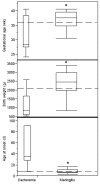Invasive Enterobacter sakazakii disease in infants
- PMID: 16965695
- PMCID: PMC3291213
- DOI: 10.3201/eid1208.051509
Invasive Enterobacter sakazakii disease in infants
Abstract
Enterobacter sakazakii kills 40%-80% of infected infants and has been associated with powdered formula. We analyzed 46 cases of invasive infant E. sakazakii infection to define risk factors and guide prevention and treatment. Twelve infants had bacteremia, 33 had meningitis, and 1 had a urinary tract infection. Compared with infants with isolated bacteremia, infants with meningitis had greater birthweight (2,454 g vs. 850 g, p = 0.002) and gestational age (37 weeks vs. 27.8 weeks, p = 0.02), and infection developed at a younger age (6 days vs. 35 days, p<0.001). Among meningitis patients, 11 (33%) had seizures, 7 (21%) had brain abscess, and 14 (42%) died. Twenty-four (92%) of 26 infants with feeding patterns specified were fed powdered formula. Formula samples associated with 15 (68%) of 22 cases yielded E. sakazakii; in 13 cases, clinical and formula strains were indistinguishable. Further clarification of clinical risk factors and improved powdered formula safety is needed.
Figures

References
-
- Centers for Disease Control and Prevention. Enterobacter sakazakii infections associated with the use of powdered infant formula—Tennessee, 2001. MMWR Morb Mortal Wkly Rep. 2002;51:297–300. - PubMed
-
- Joker RN, Norholm T, Siboni KF. A case of neonatal meningitis caused by a yellow Enterobacter. Dan Med Bull. 1965;12:128–30. - PubMed
Publication types
MeSH terms
LinkOut - more resources
Full Text Sources
Other Literature Sources
Medical
